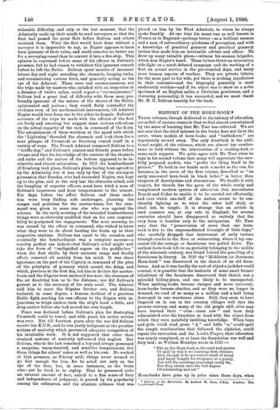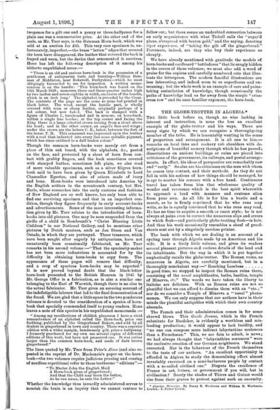HISTORY OF THE HORN-BOOK.'
THESE volumes, though dedicated to the infancy of education, are so full of mature research that we feel almost overwhelmed
by the store of learning that Mr. Tuer has collected. We are not sure that the chief interest in the books does not lie in the cover, where models of horn-books and " battledores " are ingeniously stowed away. The only drawback is the addi- tional weight of the volumes, which are almost too cumber- some to hold without the intervention of a reading-desk or some such support. We quite agree with Mr. Tner when he says in his second volume that many will appreciate the care- fully prepared models, who " prefer the thing itself to its picture." To hold in our hands such a model as the one, for instance, in the cover of the first volume, described as "an early uncovered born-book in black letter," is better than chapters of descriptions and dimensions. We handle it with respect, for therein lies the germ of the whole costly and complicated modern system of education that necessitates Boards and Codes to enable it to be carried out effectually, and over which one-half of the nation seems to be con- tinually fighting as to what the other half shall, or shall not, be taught. It is strange that an article in such common use, at any rate in England, for several centuries should have disappeared so entirely that the very form is familiar only to the antiquarian. Mr. Tuer says that the "preservation of more than one horn- book is due to the unpremeditated foresight of little boys," who carefully dropped that instrument of early torture through cracks in the floor or wainscoting, where it lay con- cealed till the cottage or farmhouse was pulled down. The earliest horn-book left to us, probably belonging to the middle of the sixteenth century, was found behind the panelling of a farmhouse in Surrey. In 1828 the "Middleton (or Bateman) Horn-book" was discovered in the thatch of an old farm- house. And as it was hardly the sort of object a jackdaw could conceal, it is possible that the instincts of some small former inhabitant of the farmhouse discovered that thatch was a splendid hiding-place, and one likely to be unsuspected. When spelling-books became cheaper and more universal,
horn-books became obsolete, and as they were no longer in demand, we read of so many as a million and a half being
destroyed in one warehouse alone. Still, they seem to have lingered on in use in the country villages well into the present century, and many of the old people still alive may have learned their " criss - cross row " and been duly admonished over the knuckles or head with the object from which they were painfully imbibing knowledge. When boys and girls could read great " A " and little "a," could spell the simple combinations that followed the alphabet, could repeat the invocation and the Lord's Prayer, their education
was nearly completed, or at least the foundation was well and duly laid ; as William Hornbye wrote in 1622 :— "Eke as the Horn-book is the seed and grains Of skill by whhh we learning first obtaine; And, though it be accounted small of many And haply bought for twopence or a penny, Yet will the teaching somewhat costly be, Ere they attain unto the full degree Of scholarship and art."
Horn-books have gone up in price since those days, when • Hist,ry of the Horn-book. By Andrew W. Thor, F.S.A. London: The
LaArlanball Pram.,
twopence for a gilt one and a penny or three-halfpence for a plain one was a remunerative price. At the other end of the scale, as Mr. Tuer says, is the Bateman Horn-book, which was geld at an auction for £65. This very rare specimen is, un- fortunately, imperfect,—the brass "laden" edges that secured the horn have disappeared, the leather that covered the back is frayed and worn, but the device that ornamented it survives. Hone has left the following description of it among his hitherto unpublished notes :—
" There is an old and curious horn-book in the possession of a gentleman of antiquarian taste and learning—William Bate- man of Middleton, near Bakewell, Derbyshire—which he most obligingly forwarded to me for inspection A written memo- randum is on the handle : This horn-book was found on the 10th March 1828; measures three and three-quarter inches high by two inches and seven-eighths in width, exclusive of the handle, which is an inch long.' The alphabet is preceded by the Cross. The contents of the page are the same as mine but printed in black letter. The wood, except the handle part, is wholly covered with roan or sheep leather, originally perhaps of a red colour, but now faded. The back is stamped with a figure of Charles I., bareheaded and in armour, on horseback, within a single line border; at the top corner and facing the King there is a large celestial crown issuing from a cloud above his head ; and in the other corner, an angel's face and wings ; under the crown are the letters C. K., below, between the feet of the horse. T. H. This ornament was impressed upon the leather with a tool that indented into every line some metallic pigment, which has since oxidised to a dull leaden colour."
Though the common horn-books were merely cut from a piece of thin oak board, with the alphabets, &c., pasted on the face, and protected by a sheet of horn from con- tact with grubby fingers, and the back sometimes covered with stamped leather, sometimes left plain, we also read of more valuable specimens, such as a silver filigree horn- book said to have been given by Queen Elizabeth to Lord Chancellor Egerton, and also of others made of ivory and bone. Horn-books were introduced into America by the English settlers in the seventeenth century, but Mrs.
Earle, whose researches into the early customs and fashions of New England are so well known, has only been able to find one surviving specimen and that in an imperfect con- dition, though they figure frequently in early account-books and advertisements. Some of the more interesting informa- tion given by Mr. Tiler relates to the introduction of horn- books into old pictures. One may be seen suspended from the girdle of a child in Rembrandt's "Christ Blessing Little Children" in our National Gallery, and he mentions other pictures by Dutch masters, such as Jan Steen and Van Ostade, in which they are portrayed. These treasures, which have been sought after eagerly by antiquarians, have not unnaturally been occasionally fabricated, as Mr. Tuer remarks in his second volume :—" That the spuriosity-maker has not been more industrious is accounted for by the difficulty in obtaining horn-books to copy from. The appearance of these pages will remove that difficulty,
and a crop of spurious horn-books may be expected." It is now proved beyond doubt that the black-letter horn-book presented to the British Museum in 1845 by Mr. George Offor is a fabrication, as is also a similar one belonging to the Earl of Warwick, though there is no clue to the actual fabricator. Mr. Tuer gives an amusing account of
the indefatigable labours that led to the final demonstration of the fraud. We are glad that a little space in the two ponderous volumes is devoted to the consideration of a species of horn- book that specially commended itself to young readers. Hone leaves a note of this species in his unpublished memoranda :—
" Among my recollections of childish pleasures I have a vivid remembrance of an alphabet called the Horn-book, price one farthing, published by the Gingerbread Bakers, and sold by all dealers in gingerbread in town and country. There was a superior edition with a wider margin, handsomely gilt, price a halfpenny. I formerly purchased for my own use several copies of different editions of this work, but have not preserved one. It was rather larger than the common horn-book, and made of dark brown gingerbread."
The lines quoted by Mr. 'liner from Prior's Alma (and also re- peated in the reprint of Dr. Mackenzie's paper on the horn- book—the two volumes require judicious pruning and erasing of needless repetitions) refer to these toothsome " editions":— " To Master John the English Maid A Horn-book gives of gingerbread ; And that the Child may learn the better, As he can name, he eats the Letter."
Whether the knowledge thus inwardly administered serves to nourish the brain is an inquiry that we cannot venture to follow out; but there seems an undoubted connection between an early acquaintance with what Tickell calls the " sugar'd plane, o'erspread with beaten gold," and the saying, denoting riper experience, of "taking the gilt off the gingerbread." Fortunate, indeed, are they who buy their experience so cheaply.
We have already mentioned with gratitude the models of horn-books and cardboard" battledores" that lie snugly hidden in the covers of these volumes ; we must also add a word of. praise for the copious and carefully numbered cuts that illus- trate the letterpress. The modern fanciful illustrations are less interesting, and indeed seem to us superfluous and un- meaning; but the whole work is an example of care and pains- taking assimilation of knowledge, though occasionally the paths of knowledge lead us far away from the simple "criss- cross row" and its once familiar exponent, the horn-book.



































 Previous page
Previous page